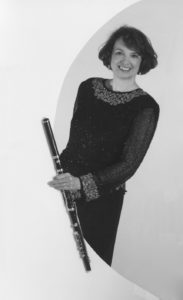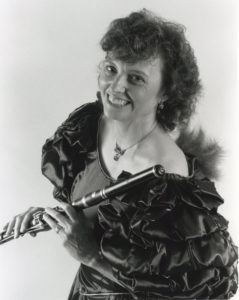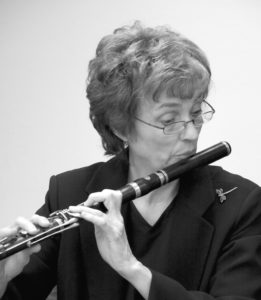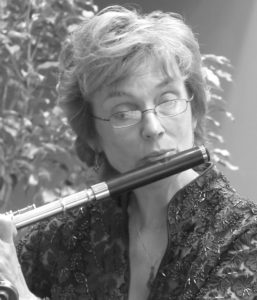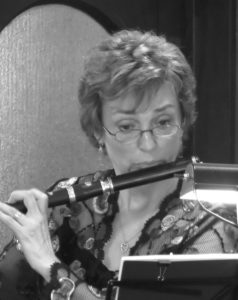My Early Flute Story
My initial interest in nineteenth-century flutes dates back to 1980.
I had been performing as a Duo with John Dowdall occasionally for a couple of years as a flute and guitar duo using modern instruments (and occasionally one-keyed flute) with modern guitar. In March of 1980, I was invited to present a lecture on eighteenth-century performance practice at the Washington D.C. National Convention of the National Music Teachers Association. [I was a graduate student at the University of Iowa working on my doctorate under the guidance of Betty Bang Mather, and my world revolved around the traverso and eighteenth-century performance practices at that time.] John Dowdall collaborated with me in the presentation providing the continuo part. We took the opportunity to spend two days in the Library of Congress seeking music for flute and guitar. We had secured in advance letters of reference from the University of Iowa Libraries and were subsequently admitted as proper scholars to the bowels of the library – those wonderful ‘sub-basements’ of the library –– where we were given free access to the stacks. This was a researcher’s heaven. Little did we know that what we would find would chart the course of our work for years to come.
In the boxes of flute and guitar music – each marked alphabetically A C, D-F, and so on – were many scores from the first half of the nineteenth century. We were surprised to find so much from this period _ variations, serenades, opera potpourris, waltzes, nocturnes and more. [John Dowdall subsequently wrote his MA dissertation on the subject. See Flute and Guitar Duets of the Early Nineteenth Century in the Library of Congress, University of Iowa, 1982]. Music from circa 1850-1950 was essentially absent, then gradually picked up again for the balance of the 20th-century. Subsequently, we learned that house music was a favorite pastime of the newly emerging middle class and the portable flute and guitar (along with violin and piano) were favorite salon instruments in Europe. The flute was the most popular wind instrument of both the 18th and nineteenth centuries. And the addition of the 6th string on the classical guitar in about 1780 made it the perfect accompanying (chordal) instrument.
As I mentioned earlier, I had an avid interest in period instruments – and was a frequent performer on the one-keyed (Baroque) flute. John, too, was interested – his experience was with Renaissance lute. We asked ourselves, “What vintage flute and guitar would be appropriate to perform the early nineteenth-century music we found in the Library of Congress?” We went our separate ways, researched and explored. I borrowed an 8-keyed wooden flute that my sister had purchased in a flea market in Phoenix Arizona and learned to play it. It wasn’t a very good instrument, an unsigned 8-keyed flute, possibly of Sears and Roebuck vintage, but adequate to learn the fingering systems. John learned to his surprise that he had a nineteenth-century instrument in his personal collection _ a fine little guitar he had purchased in an auction house in Vienna with a label that read Anton Hasslwanter, Innsbruck.
What did I think of that 8-keyed flute? It was clearly a love-hate relationship. I loved the sweet, yet projecting tone of the instrument. I learned to play it completely without vibrato. The fingering systems proved to be challenging. Unlike the modern flute, most pitches have several fingering options, and the choice depends on the peculiarities of the particular flute, the notes surrounding this note, and its function. It was a steep learning curve. Complicating the matter was determining the pitch that my particular flute favored. Was it A-440, or A-446. The challenge was to find a placement for the cork and the barrel where the most notes played in tune. I chose the D Major and G Major scales as a point of departure. I spent hours and hours each week working through the difficulties of intonation. After a year or two, I acquired a better instrument, a lovely circa 1830 8-keyed French flute by Clair Godfroy purchased from David Shorey in August, 1983.)
First performances:
After intense personal work, we reemerged to begin adding some easier nineteenth-century duets on period instruments to our touring concert repertoire. As we gained technical skill on these instruments we began to design our touring concert programs half on period nineteenth-century instruments and then, after intermission, half on modern instruments/repertoire. John was invited by the Guitar Foundation of America to present a paper/concert of this Library of Congress repertoire in New Haven Connecticut in October, 1981. So we showed up with our old instruments, John’s modestly projecting little guitar, and my rather odd looking flute. Most listeners didn’t quite know what to think, but one guitarist/musicologist Matagna Ophee became a mentor and colleague in this narrow field of period-instrument performances of nineteenth-century music.
We recorded our first compact disc recording in June, 1986, just 6 years after our initial introduction to our nineteenth-century period instruments and their potential. By this time (1986) I had purchased my second early flute, a lovely circa 1820 11-keyed flute by Stephan Koch from Tony Bingham in London. I look back and think how brave we were to put the music and these newly explored instruments ‘out there’ and I’m surprised at how quickly our work was acknowledged. First, our new disc, Guiliani, Hummel, et al (Titanic Records TI-161) was given accolades and named Disc of the Month, by the German magazine Tage Musik Aktuell.
A prestigious early music presenter in Regensburg Germany invited us to perform at the 1989 Tage Alter Musik. This was a stretch for this early music festival, because at this time early music was loosely defined as music before 1750. I suspect that the intrigue was because we performed this ‘newer’ music on period instruments. The response was warm and reviews were particularly encouraging. Since that time, and very slowly, early nineteenth century music has been more and more accepted in the definition of ‘early music.”
The second disc of flute/guitar music, also named Disc of the Month, by the German magazine Tage Musik Aktuell, followed in 1992 _ Rossini, Mozart, et al (Titanic Records TI-182). Our interest then turned to American music and our third disc of Duo music titled Home Sweet Home (Koch International Classics, 1995) featured the music of Stephen Foster and Septimus Winner.
The third disc was of American Parlor Music, repertoire with very simple tunes and harmonies. Would I manage to make this instrument sing in the way I heard it in my head? It is, in some ways, far risker to play simple tunes than more complex ones. There is nothing to hide behind. I was pleased beyond words with a review from a British flutist who himself had experienced playing this tricky yet beguiling old instrument. Dennis Clark was his name and he reviewed the disc in Pan-The Flute Magazine (1966) saying, “My family and friends, both musical and unmusical, have enjoyed listening to this disc, partly because of the music but even more, I suspect, because it sounds as though there is a real person on the end of the flute and moreover someone who is having a good time. On hearing such musical and technically competent playing with such a beguiling sound I began to wonder how the Boehm flute ever caught on.”
The beginning of the Red Cedar Trio
Finding a violist.
We became aware of the beautiful music of the Czech composer Wenceslaus Matiegka. He wrote no duo music for flute and guitar, but he wrote 3 large works for flute, viola and guitar. Thus began our quest to find a period instrument violist who specialized in nineteenth-centurymusic. Wherever our concert tours took us, we sought out in advance violists with whom to read, and we read with violists in Denver, Minneapolis, and London, learning what kind of sound and balance we could expect from a bowed string instrument. One day we asked ourselves, “If we could work with anyone on in the universe, who would it be?” Our unanimous answer was, “The violist on that disc we love [The N.Y.-based Classical Quartet]. That was David Miller, and the stars were aligned. The Handel Haydn Orchestra (David Miller was principal viola) was coming to Iowa to be in residence at the University of Iowa, just forty minutes south of our home base, over a spring break in 1986. We invited to our home on Easter Sunday, and after lunch, we sat in our living room as the sun streamed in the window, and read Matiegka Trio, Op. 21. That was the beginning of a marvelous fifteen-year collaboration, and we subsequently read and performed nearly every nineteenth-century trio for this instrumentation we could find.
We recorded all for of Matiegka’s works on period instruments to compact disc. It was important to us to read from the original manuscript (we avoid modern editions when possible.) Fleur de Son Classics (Buffalo, NY), a record label that takes special interest in little known works, became our recording company.

